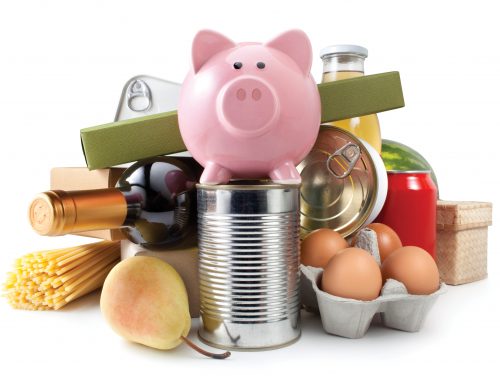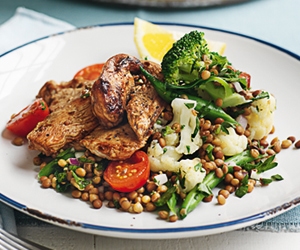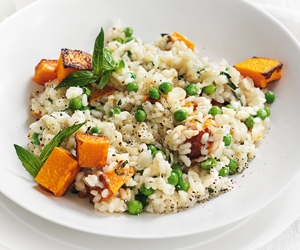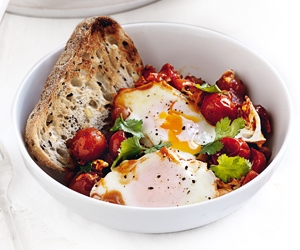
With the right basics in your pantry, these essential ingredients will change the way you eat and save you money at the checkout.
The latest food trends always seem to focus on a few expensive ingredients that promise to change your life forever. If only it were that simple.
The truth is, you can eat healthily without spending a fortune at the health food store, or buying the latest ‘superfood’. Here are our best money-saving tips.
Back to basics
Ready-made meals may look like an attractive option when you are time poor – but they’re usually a false economy.
Cooking from scratch can be almost as quick, is cheaper and, often, a whole lot tastier. Forget about top-of-the-range ingredients too. You can still get the same number of nutrients and great flavour from budget buys.
Find good value
Check out the ‘Odd Bunch’ initiative at Countdown. You can buy wonky-shaped, but still fresh, fruit and veges that wouldn’t usually make the shelf. They’re sold at a reduced price, saving you money. The scheme also helps producers and stores cut down on food waste.
This product got us thinking about other well-priced ingredients. Below you’ll find the best-value, healthiest ingredients that will help you make quick, nutritious, low-cost meals for the whole family.
At the shops
Dollar-saving tips for the supermarket
1. Think outside fresh: Canned or frozen fish, vegetables and fruit tend to be cheaper than fresh but are just as nutritious. There’s minimal preparation needed (saving you time), zero wastage, and a long use-by date.
2. Scan the shelves: You’re more likely to buy products that are at eye or hand level, or have more shelf space. But these are usually the best sellers and not necessarily the cheapest brands. Look up and down to check if there’s a similar product for a better price.
3. Be bargain savvy: Buying ‘two for the price of one’ is only good value if you were planning to buy that product in the first place, otherwise it’s making you pay more. But if you think it’s a healthy buy and a good substitute for your usual purchase, then it’s a money saver. Also consider the use-by dates and if you have the storage space.
4. Take a time check: It’s usually more expensive to buy time-saving ingredients such as chopped veges and meat, bagged lettuce and grated cheese. Ask whether they really save you that much time in the kitchen — could you rope in an extra (free) pair of hands at home to help with basic prep instead?
5. Know your dates: The use-by date shows when a food should be eaten by, for health reasons. But the best-before date is the cut off for when a food is at its optimum. Eating foods a few days, or even weeks after a best-before date is acceptable and should not cause you any harm.
6. Don’t be a brand snob: Generic-labelled basics such as beans, canned tomatoes, flour, pasta and rice do the job just as well as expensive brands.
Love your leftovers
How to reinvent last night’s dinner
Sunday roast: Make a speedy and tasty stew by simmering cooked meat with leftover veg in a small amount of reduced-salt stock, then stir in a handful of fresh or dried herbs and frozen veges just before serving.
Pasta: Mix cooked pasta with your favourite tomato-based sauce and some frozen veg, then top with grated reduced-fat cheese and bake. Or do as the Italians do and add leftover spaghetti to frittatas.
Vegetables: Brighten up roasted vegetables, such as capsicum, pumpkin and kumara, with an easy dressing of harissa paste and orange juice, then toss together with crisp salad leaves and a small handful of toasted nuts or seeds. Yum!
Mashed potato: Freeze any spare for cottage pie, or mix with canned fish, frozen peas and spices to make simple fish cakes.
Rice: Freeze, then transform into a quick fried rice with veges and a dash of reduced-salt soy sauce, and top with a fried egg.
Think like a bargain hunter
Tweaks that will save you cash
1. Take stock before you shop: Check what you already have in the kitchen and plan your meals around items that need using up.
2. Time it right: Stock up your fridge when the supermarket is marking down chilled items, such as fish, meat, dairy and veges. This is often done just before closing time, or at the end of the week.
3. Make extra: Batch cooking may take time, but it can save you lots of fiddly prep on a busy weeknight and it saves money on takeaways for evenings when you don’t feel like cooking from scratch. Think soups, casseroles and curries to cook in bulk.
4. Go meat free: A few vegetarian meals every week will help meet your five-plus-a-day target, boost fibre and even cut food bills.
Feed a family of four for under $15
Whip up these no-fuss weeknight meals that won’t break the bank!
Balsamic chicken with warm lentil salad

Marinate 500g chicken breast in 2 tablespoons balsamic vinegar, 2 teaspoons garlic and 1 teaspoon cumin seeds. Cook chicken in a frying pan for 2 minutes each side. Add 75g chopped cherry tomatoes to the pan for 3 minutes. In a bowl, combine 3 cups steamed veg with 1/2 chopped red onion, 400g can lentils, 1/3 cup chopped fresh parsley and juice of 1 lemon. To serve, divide veges among 4 plates, top with grilled chicken and tomatoes, and crusty fresh bread on the side.
Roasted pumpkin and pea risotto

Peel and chop 500g pumpkin into chunks and roast for 20 minutes. In a pan, heat 2 cups reduced-salt vege stock with 2 cups water. In another pan, gently fry 1 chopped onion in olive oil for 5 minutes. Add 1 1/2 cups arborio rice and stir well. Add ½ cup hot stock to rice and stir until liquid absorbs. Repeat for 20 minutes, or until rice is al dente and creamy. Stir in 1 cup frozen peas and ¼ cup grated parmesan, until warm. Serve in bowls. Top with fresh mint leaves.
Moroccan-spiced eggs

Gently fry 2 sliced red capsicums and 1 sliced red onion in olive oil for 3 minutes. Add 2 x 400g cans five-bean mix and 1 1/2 tablespoons Moroccan seasoning. Add 2 x 400g cans chopped tomatoes to pan with 1/2 cup water. Simmer for 7 minutes, or until thick. Crack 8 eggs into 8 small wells in mixture. Cover pan with lid and cook for 3 minutes, or until eggs set. Divide among bowls and garnish with chopped fresh coriander. Serve with toasted sourdough or grainy bread.
Baked kumara with tuna and sour cream

Halve 4 small orange kumara, wrap in foil and bake (cut-side up) for 30 minutes. Remove foil and bake for a further 20 minutes. Scoop out inner flesh of kumara and mash with 2 cups steamed broccoli, 95g can tuna, 1 cup canned or frozen corn, 2 sliced spring onions and 1/4 cup light sour cream. Spoon mixture back into kumara shells and top with 1/2 cup grated reduced-fat cheese. Bake for 10 minutes, until golden. Serve with baby spinach dressed in vinaigrette.
Thrifty tip: Frozen veges have come a long way. Look out for jumbo bags of stir-fried veges, or individual steam-fresh bags of greens that make it quick and easy to add loads of veges to any meal.
Thrifty tip: Lemons help revive leftovers, so add a quick squeeze of lemon juice or a little grated zest to your slow-cooked casseroles or stir-fries.
Thrifty tip: Eat red meat sparingly. One small steak, thinly sliced, will serve two when tossed through a salad or alongside protein-rich lentils or chickpeas. Try our Warm beef and lentil salad.
www.healthyfood.com










